“Are you trying to be funny?” -Colin Baker as the Doctor
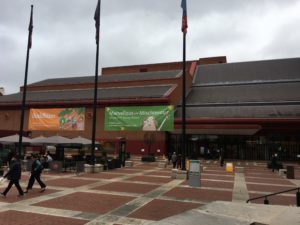
After a slow start to the morning (sometimes you have to have a slow start), Amy and I headed off to the British Library via the Victoria line to the King’s Cross St. Pancras station (where we’ll return to again very early on Wednesday morning in order to depart via the Eurostar for a day trip to Paris). St. Pancras is a large international railway station, and it’s worth going out of the way for just to marvel at the architecture alone: a large red brick Victorian gothic building with a tall, elegant clock tower at its southeast corner. Irritatingly, during the 1960s, plans surfaced to demolish the building, but opposition was so fierce that a huge renovation project was undertaken instead. And thank goodness for that, as it’s a gorgeous, gorgeous building, and it would’ve been a crime to tear it down.
The nearby British Library, on the other hand, deserves to be torn down because it’s actually really ugly, a building that wouldn’t look out of place on a United States college campus: red brick arranged in stark lines of no character, a series of imposing black mono-pitched roofs, a courtyard of more red brick and cement arranged in boring and uninspiring squares. The fact that it’s right next to the supremely exquisite St. Pancras International building only magnifies how utterly grotesque and hideous the British Library building is. And to think that the largest library in the world (by number of items in the catalogue) is honored with this monstrosity frankly boggles my mind. But oh well, I don’t have to look at it every day.
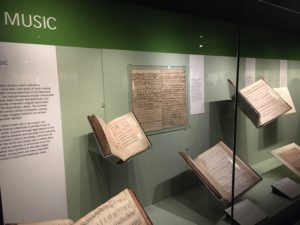
Anyway, the point of our visit was to view the Treasures of the British Library exhibit, which has on display quite a few items I’ve wanted to see for quite some time: original manuscripts by Handel, Britten, Bach, Mozart, Schoenberg, and more; a copy of Shakespeare’s First Folio (we had previously seen another copy at his house in Stratford); a Gutenberg Bible; handwritten lyrics by the Beatles; and a copy of the Magna Carta, which was a real inspiring moment in particular. I’ve long wanted to make this pilgrimage to the British Library to view these incredible items in their collection, and I’m so happy I finally have. I’ll have to return again some day to explore more of the library, as its a vast, vast collection and the Treasures exhibit is only a small, small (albeit significant) part of the whole collection. Perhaps next time, however, I’ll wear a blindfold on my approach to the library, so as to prevent damage to my retina should I gaze on its hideous exterior again.
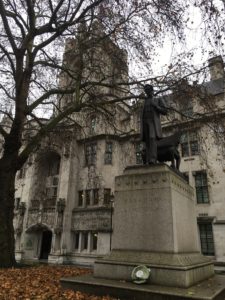
Following the library, we made our way back to the City of Westminster to attend a guided tour of the Palace of Westminster. With some time to spare before the tour and feeling a need for some tea and a bite to eat, we discovered a cafe in the nearby Supreme Court building called, er, the Supreme Court Cafe, where a large stately bust of Edward VII surveyed all the cafe tables with a commanding stare. Near the cafe, we passed by a mini exhibit highlighting the history of the court where we learned that the British hilariously didn’t have a Supreme Court until 2009, created by Parliament with a 2005 act that declared that the new court would inherit the judicial duties of the House of Lords, thereby creating a clearer separation of powers between legislative and judicial duties of the government. (I wonder where they got this idea from. Sounds familiar somehow.)
Following an average tea I wouldn’t label supreme in any way, we headed over to Parliament to attend what ended up being a really engaging and informative tour of the Palace of Westminster. I highly recommend prioritizing a guided tour of the building, and make sure you buy your tickets at least a couple days in advance (maybe even further in advance depending on the time of year) as they do sell out.
The tour includes visits to quite a few important rooms. We were allowed to gaze upon Westminster Hall, which is the oldest part of all of Parliament dating from 1097 (yes, 1097) when the palace was used as a royal residence. Today, its stone walls, elegant and ornate ceiling, and hammer beam roof is used for the U.K.’s lying-in-state ceremony, reserved for deceased monarchs and—on rare occasions—particularly prominent individuals like Winston Churchill. We also got to see the Central Lobby, the main area for traffic between the House of Lords and the House of Commons and also the space where the BBC would broadcast from should they be reporting on news from Parliament. It’s an opulent space of elaborate mosaics of patron saints; a golden ornate domed ceiling; decorative floor tiles of slate, cream, blue, and red; and statues upon statues of kings and queens.
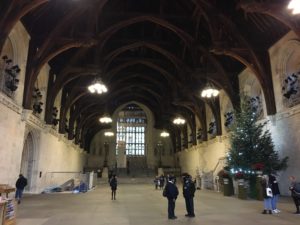
A visit to Parliament wouldn’t be complete without a visit to the House of Commons chamber, the large room lined with the iconic green benches and which is the room that seems to get most of the attention on the news: MPs yelling at each other to defend their position; the speaker of the house screaming, “Order!” to calm the robust dialogue; the opposition booing the Prime Minister at every chance. The visit to the House of Lords chamber, on the other hand, highlights some stark differences between the two chambers. It was grander because this is the room where the queen sits at the state opening of Parliament in a large ornate wooden throne placed prominently beneath an equally ornate golden canopy at the head of the chamber. There were also elegant golden arches framing tall stained glass windows depicting various coats of arms, and, of course, the four rows of red cushioned benches running parallel to the long chamber walls.
The tour guide was also so, so knowledgeable, regaling us with stories about how no one can touch the statue of Winston Churchill anymore because his foot has worn down due to MPs rubbing it for good luck before a vote; how Margaret Thatcher was disappointed to learn that that her statue was made of bronze rather than iron as befitted her nickname, the Iron Lady; how MPs have eight minutes to return to Parliament after the Division Bell has rung in the case where a vote needs to be taken by MPs filing into either a yay or nay chamber; how one MP was in the toilet on the nay side when the bell was rung and couldn’t leave the toilet until the vote was over because then he’d’ve cast a nay vote thereby also missing his chance to vote yay; how at the state opening of Parliament there is a senior officer called the Black Rod, who uses a staff to knock on the door to the House of Commons after it has been slammed in their face as a symbol of the independence of the House of Commons from the House of Lords, a section of the door worn down because of decades of knocking; the doors are then opened and then the MPs in the Commons are led to the Lords so they can hear the queen’s speech.
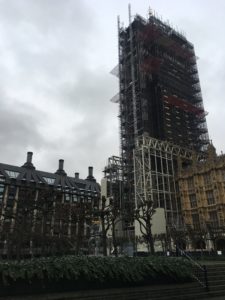
Following a simply marvelous and informative visit to Parliament, Amy and I made our way to the Old Vic (discovering the Leake Street Arches on the way: an old disused tunnel that has been reimagined with vibrantly colorful graffiti art; various businesses also repurposing the space for their use, where we had the most mediocre and bland pho while listening to horrible, horrible music at Banh Boa Brothers) to meet up with Aaron to enjoy a production of A Christmas Carol.
This production was—shall we say—different. Describing something in that way (especially when exclaimed as, “Well, that’s different!”) is Minnesotan for, “Not very good at all.” Like the Leake Street Arches, this production was also a reimagining, except that sometimes a story is so, so great and so, so classic, and so, so iconic, that any reimagining just simply will not work no matter how skilled the artists. And this is the Old Vic, we’re talking about here, an icon in its own right.
Something was off from the very start. It was all very monochrome, carolers and musicians singing jolly Christmas tunes but dressed in long black coats and black top hats as if they were attending a funeral. And this one-note aesthetic bled through the entire production. While it was exciting to see Patterson Joseph (of Peep Show acclaim) on stage, I don’t think the part works for him. Whether it was due to the actor’s choices or Matthew Warchus’s direction, I felt that all Joseph did was scream and yell. Scrooge is, of course, an unpleasant fellow who should scream and yell from time to time, but the character should also be terribly unpleasant with his scornful whispered remarks (“I wish to be left alone”), terribly sympathetic when a tear roles down his cheek at the site of his younger self sitting all alone at school reading a book (“I was a boy here”), and terribly relatable when he’s a reformed new man (“I will honor Christmas in my heart and try to keep it all the year”). None of those shades were present in this production. It was all, well, monochromatic.
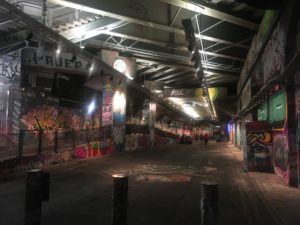
I think much blame lies at Jack Thorne’s adaptation as well. He got rid of iconic moments like the bells ringing in Scrooge’s home before Marley’s ghost appears. He made curious narrative choices, adding a chorus of actors that essentially read from the book to describe what’s happening rather than just showing us what’s happening. He supplanted Scrooge’s dead sister Fan for the Ghost of Christmas Yet to Come. He even got rid of Tiny Tim’s use of crutches and an iron frame! By the end of the first act, Scrooge was still just yelling and screaming with no hint of his transformation to come. The entire arc of Scrooge’s character was totally ignored.
The list of sins is endless: the Ghosts of Past and Present were dressed identically in ugly, ugly dresses of a patchwork of maroons and creams while inexplicably pushing a trolley with a lantern on it; Fezziwig inexplicably managed a funeral home; Tiny Tim died during the present rather than the future. Worst of all, however, was when the whole play devolved into a pantomime when Scrooge was preparing to bring a feast to the Cratchit house: potatoes sliding down long white chutes of fabric into wooden harvesting buckets; Brussels sprouts literally parachuting into the audience; Scrooge almost being knocked off stage when a giant turkey on a platter came swinging in on a rope like a ridiculous chandelier. (Pantomime is, of course, uniquely British, Ian McKellen himself remarking during last night’s show, “[Pantomime] doesn’t travel well.”)
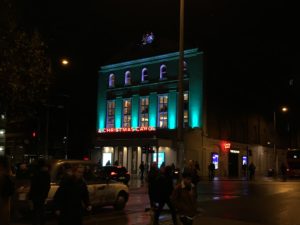
But the most confusing thing of all? The audience LOVED this shit! For real! I couldn’t believe it. They were clapping and whistling and laughing and whooping and eating all this idiocy up like it was going out of style! It was so strange. I do love the British, but there are some things I will never understand: their monarchy; their resistance to embracing the EU; and their love of pantomime, to name a few. I just don’t get it.
And so, on that note (and with apologies for the length of this post; I try to keep them at 1000-1200 words, this one clocking in at over 2000), a rather manic day filled with such rewarding moments at the British Library and Parliament and such angering moments at the Old Vic. We can’t always win.
Our adventures continue the next day with the Tower of London and the Globe Theatre…
